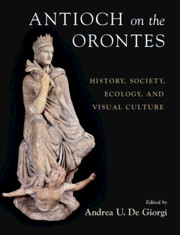Book contents
- Antioch on the Orontes
- Antioch on the Orontes
- Copyright page
- Dedication
- Contents
- Plates
- Figures
- Tables
- Contributors
- Abbreviations
- Antioch on the Orontes
- Part I Beginnings
- Part II The Making of a Capital
- Part III The People of Antioch
- Part IV Religion
- Part V Crises and Resilience
- Chapter 27 Earthquakes and State Response at Antioch
- Chapter 28 Disasters and Divine Wrath
- Chapter 29 Infectious Disease and Its Repercussions in Sixth-Century Antioch
- Chapter 30 Memory and the City
- Index
- Plate Section
- References
Chapter 30 - Memory and the City
Reflections from the Post-Interesting on Islamic Antioch
from Part V - Crises and Resilience
Published online by Cambridge University Press: aN Invalid Date NaN
- Antioch on the Orontes
- Antioch on the Orontes
- Copyright page
- Dedication
- Contents
- Plates
- Figures
- Tables
- Contributors
- Abbreviations
- Antioch on the Orontes
- Part I Beginnings
- Part II The Making of a Capital
- Part III The People of Antioch
- Part IV Religion
- Part V Crises and Resilience
- Chapter 27 Earthquakes and State Response at Antioch
- Chapter 28 Disasters and Divine Wrath
- Chapter 29 Infectious Disease and Its Repercussions in Sixth-Century Antioch
- Chapter 30 Memory and the City
- Index
- Plate Section
- References
Summary
The AD 637 Islamic conquest of Antioch has been typically held as the city’s swan song. Conversely, this article shows that the new realities of power ushered in a new phase in the life of the city and lingered on the memory and myth of the city of Seleucus Nicator.
- Type
- Chapter
- Information
- Antioch on the OrontesHistory, Society, Ecology, and Visual Culture, pp. 489 - 506Publisher: Cambridge University PressPrint publication year: 2024



